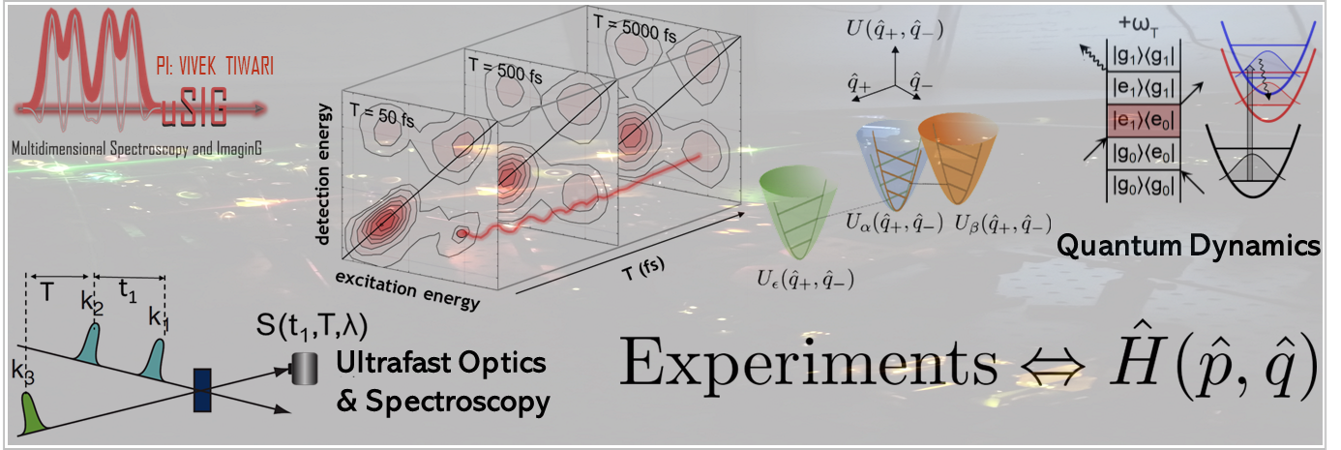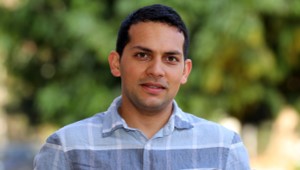

Associate Professor
BS/MS IIT Kanpur
Ph.D. Chemical Physics,
University of Colorado, Boulder
Email: vivektiwari@iisc.ac.in
Welcome to Multidimensional Spectroscopy and Imaging Group [‘musig‘]
New Spectroscopy Methods | Imaging Tools | Quantum Dynamics & Exciton Physics | Theory & Computational Spectroscopy
We are an interdisciplinary group of physicists and physical chemists who work at the interface of experiment and theory. We are broadly interested in how exciton physics manifests in materials and molecular assemblies from the perspective of quantum dynamics. We develop advanced optical spectroscopy techniques and quantum dynamics models to probe a variety of questions in condensed matter physics and chemistry, which ultimately determine material functionality. Such questions include – how does an exciton transport in a lattice, how does it dissociate to yield charge carriers, and why is this yield efficient in certain materials versus poor in others? Can we learn quantum transport principles from natural photosynthesis ? Can natural photosynthesis guide the design of new photovoltaics with improved charge generation, etc. ? We are also interested in applied aspects of spectroscopy such as inventing better sensing, imaging and diagnostic tools. Some current systems of interest include –
- Exciton physics in molecular assemblies
- Quantum transport in disordered systems
- Electronic polaritons
- Singlet exciton fission
- Ultrafast imaging of defects in quantum materials
Please go over our recent publications for a flavor of the kind of experimental and theoretical work carried out in the group. Visit our homepage or our laboratory to know more about our current directions. If you are interested in the same questions as we are, please email me your CV along with your research interests.
- Asha S. Thomas*, Vivek N. Bhat*, and Vivek Tiwari, “Rapid scan white light two-dimensional electronic spectroscopy with 100 kHz shot-to-shot detection”, J. Chem. Phys. (2023), 159, 244202. link (*denotes equal authors). Editors’ Choice Feature Article (top 3% papers in the field selected by the editors). Patents IPO/202241074681 and PCT/IN2023/050664. Read IISc Press release here – Exciting Everything Everywhere All At Once
- Atandrita Bhattacharyya, Amitav Sahu, Sanjoy Patra, and Vivek Tiwari, “Low- and high-frequency vibrations synergistically enhance singlet exciton fission through robust vibronic resonances”, Proc. Natl. Acad. Sci. USA (2023), 120 (49), e2310124120. link. Read IISc Press release here – Beats That Matter
- Amitav Sahu and Vivek Tiwari, “Vibrations That Do Not Promote Vibronic Coupling Can Dominate Observed Lineshapes in Two-Dimensional Electronic Spectroscopy“, J. Phys. Chem. Lett. (2023), 14, 4617.
- Vivek N Bhat*, Asha S Thomas*, Atandrita Bhattacharyya and Vivek Tiwari, “Rapid scan white light pump–probe spectroscopy with 100 kHz shot-to-shot detection”, OSA Optics Continuum (2023), 2, 1981. link (*denotes equal authors)
- Amitav Sahu, Vivek Bhat, Sanjoy Patra, and Vivek Tiwari, “High-sensitivity Fluorescence-Detected Multidimensional Electronic Spectroscopy Through Continuous Pump-probe Delay Scan”, J. Chem. Phys. (2023), 158, 024201. link
- Sanjoy Patra and Vivek Tiwari, “Vibronic Resonance Along Effective Modes Mediates Selective Energy Transfer in Excitonically Coupled Aggregates“, J. Chem. Phys. (2022), 156, 184115. link
- Vivek Tiwari, “Multidimensional electronic spectroscopy in high-definition—Combining spectral, temporal, and spatial resolutions“, J. Chem. Phys. (2021), 154, 230901. JCP Most Read Perspectives 2021 link.
- Sanjoy Patra, Amitav Sahu, and Vivek Tiwari, “Effective Normal Modes Identify Vibrational Motions which Maximally Promote Vibronic Mixing in Excitonically Coupled Aggregates”, J. Chem. Phys. Communication (2021), 154, 111106. link
- Amitav Sahu, Jo Sony Kurian and Vivek Tiwari, “Vibronic Resonance is Inadequately Described by One-particle Basis Sets“, J. Chem. Phys. (2020), 153, 224114. Feature Article (top 3% papers in the field selected by the editors). link
- Abhisek A. Mohapatra, Vivek Tiwari* and Satish A. Patil*, “Energy transfer in ternary blend organic solar cells: recent insights and future directions“, Energy and Environmental Science (2021), 14, 302. Perspective Article (* denotes corresponding authors).

